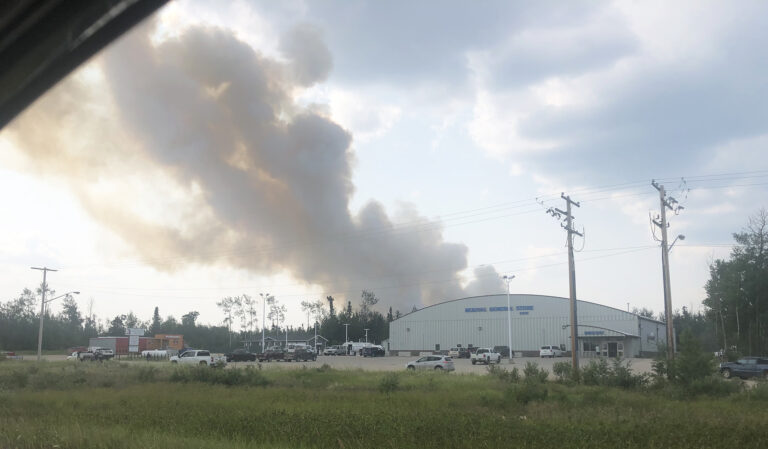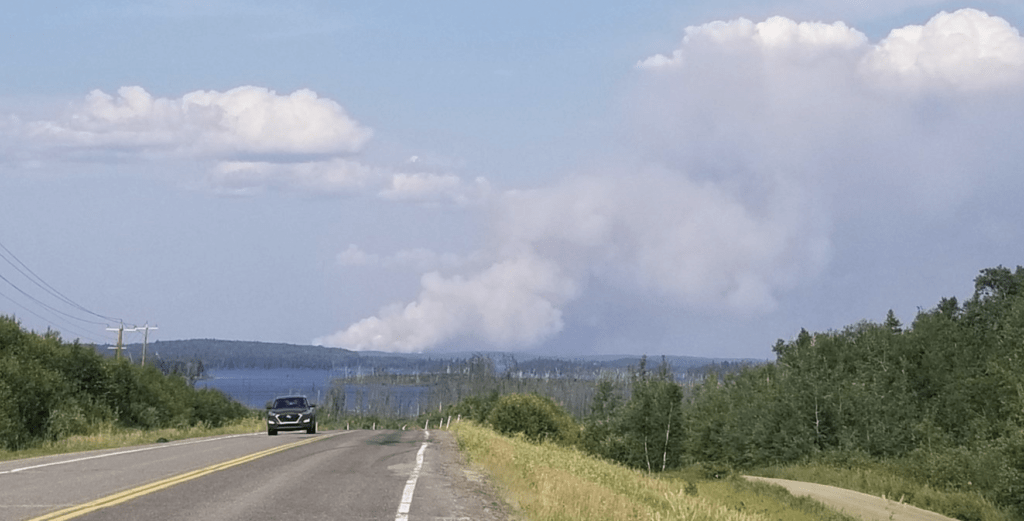
Some communities are evacuating amid a rapidly changing fire situation in northern Saskatchewan over the weekend.
Peter Ballantyne Cree Nation (PBCN) Chief Karen Bird declared a general evacuation for Southend/Reindeer Lake “due to a fire threat close to the community” on Sunday.
“We are working on the transportation for the busses to come into the community to pick up the community members… Elders will be picked up at their homes and everybody else will meet at the band office to go out on the busses,” Bird said.
“Highway 102 is closed due to a fire so we have to be assisted by a helicopter in a convoy out of the community when the busses get here. So one convoy tonight and one in the morning.”

The northwest communities of Dillon, Michel Village and St. George’s Hill began evacuations over the weekend.
As of Sunday there is a wildfire 7.7 kilometres north of Little Flatstone Lake. The English River First Nation (ERFN) has advised to avoid the area.
“This fire, known as the Manson Fire, is under ongoing assessment. Right now, all air resources are currently battling the Dillon Fire. Many people from Dillon and St. George’s Hill have been evacuated,” the ERFN said on Sunday.
“We are also monitoring the air quality. If the amount of smoke in the air becomes too thick we assure you there is a plan in place to evacuate those whose health will be put at risk.”
The ERFN said its emergency management team is prepared to handle evacuations with COVID-19 protocols.
“No large group sheltering in one large space will be happening this time.”
Lac La Ronge Indian Band (LLRIB) emergency response coordinator Maurice Ratt requested emergency firefighters on Sunday requesting anyone certified to call the La Ronge fire base.
Emergency response had skimmers and Convairs on all fires going back and forth dropping retardant lines and water.
There is a standby evacuation notice for Grandmother’s Bay residents with breathing problems, asthma, new born children, elders with limited mobility and breathing problems.
According to the Saskatchewan Public Safety Agency (SPSA), on Sunday there was no threat to the community of Grandmother’s Bay as crews worked on the fire lines with some heavy smoke.
Emergency response said the wind was in their favour — as it was pushing the fire away and into the lakes as water bombers were deployed.
On Sunday LLRIB emergency response said the Lynx fire was not a threat to Sucker River as crews worked on the fire lines with heli-support.
There was no threat to Stanley Mission as crews in the area worked with air support, setting up sprinklers in Rattlers Creek to protect cabins. There was heavy smoke at times in Hall Lake as crews worked on the fire lines but there is no reported threat to the community.
Last Thursday the SPSA predicted hot and dry weather for three to five days throughout the province. Increased storm activity starting Sunday brings rain but could come with its own set of problems due to the risk of lightning strikes.
“We will get precipitation, but that precipitation will be with lightning in most cases, further escalating our concerns,” SPSA vice president of operations Steve Roberts said.
“With increased complexity on these fires they will require more effort because of the conditions and then we also have the risk of more lightning fires that may start to occur.”
There is no reported threat to the population centres of La Loche in the northwest or La Ronge in the northeast as of Sunday.
A province wide fire ban remains in place to avoid unwanted human caused fires — that includes all Crown land and the Northern Administration District.
Wildfire situation above five-year average
Roberts said in a press conference Monday that the fire situation in Saskatchewan continues to grow above the fire-year average. He said there are 91 active fires in the province with 312 fires so far this year — which is 100 more fires than the five-year average. A number of those fires are of concern to communities in the north.
The northwest communities of Dillon, Michelle Village and St. George’s Hill are being affected by the Lock Fire. The Mule and Links fires are in the vicinity of Stanley Mission, while the GMB01 fire is near Grandmother’s Bay in the northeast. Further north the Stallard Fire remains active between Black Lake and Stoney Rapids
“All of those fires are of concern for the agency and we are taking action on those because of their proximity to communities,” Roberts said.
“So, (there are) numerous fires along that main northern quarter that we will be monitoring as well to insure that we can track and try to insure no disruption of road traffic in and out of the far north of Saskatchewan.”
Roberts said that in addition the fires currently on the books a number of fires are burning near Highway 102 along the stretch between La Ronge and Wollaston Lake.
There are five fires of concern in a cluster in the area of Southend/Reindeer Lake. The community of Stanley Mission is also on alert for evacuation as of Monday.
“The only precipitation we have seen is in the far, far north of the province. So we are getting a little bit of reprieve on some of those northern fires… but it is delivering us lightning which is causing us these new fire start,” Roberts said.
“At this time most of the new fires are lightning, we have been fortunate the fire ban has been effective and we have not seen a large number of human caused fires which benefits us in the situation we are in today.”
Meanwhile the the lower two thirds of the province continue to see this hot, dry weather with very little precipitation.
Joan Hrycyk director of emergency and crisis support said the SPSA is coordinating with the Meadow Lake Tribal Council to provide emergency accommodations, hotels, food and other necessities for evacuees.
Evacuees from that area are at one location in North Battleford. The agency also coordinated busing for Southend for evacuations and the Canadian Red Cross is also providing support.
“There is approximately 31 people who are in North Battleford. There are also community members being supported in Lloydminster,” Hrycyk said.
Roberts said that the fire is being managed with internal resources as resources across Canada and the United States are stretched.
New fires are mostly due to natural causes — which Roberts said shows the fire ban has worked. He said the province-wide fire ban will remain in place but be reviewed shortly — with possible changes for the far north.
With Daily Herald files from Michael Oleksyn
This report was updated on July 12, 2021 to include comments from the SPSA.
